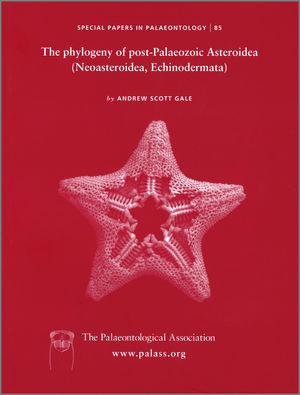Reg. Charity No. 1168330

The skeletal morphology and homologies of 24 extant asteroid taxa and one Palaeozoic outgroup (Calliasterella mira; Upper Carboniferous, Moscow area, Russia) are described in detail. This information is used to construct a character matrix to identify deep relationships within the Neoasteroidea. Particular attention is paid to the morphology and homologies of the character-rich ossicles of the mouth frame (orals, circumorals, odontophore) and of the ambulacral groove (adambulacrals, ambulacrals). In addition, new homologies between alveolar and forcipulate pedicellariae are identified. Soft-tissue characters are reviewed from the literature. Simultaneous unconstrained cladistic analysis of 128 characters yielded six equally parsimonious trees, and a consensus tree of these is presented. This places the Paxillosida as the most basal neoasteroid group, sister taxon to the Surculifera, which include all other neoasteroids. The Spinulosida (used here in its original sense) are a well-supported monophyletic group, and a newly identified clade here named the Tripedicellaria, unified by characters of the pedicellariae, includes both the Valvatida and Forcipulatida. ‘Valvatids’ are a paraphyletic group of taxa that are sister group to the Forcipulatida. The fossil record of the asteroid families to which the 24 investigated species belong is reviewed, and the stratigraphical information is used to constrain the positions of the nodes on the consensus tree. The enigmatic asteroid fossil record from the Triassic is reviewed, and it is concluded that the order Trichasteropsida is a poorly understood assemblage of diverse morphologies of which the relationships with other taxa are uncertain. Middle Triassic (Muschelkalk) asteroids are identified as neoasteroids incertae sedis and assigned to two families: Trichasteropsidae and Migmasteridae fam. nov. Well-preserved asteroid ossicles from the Carnian of the Italian Dolomites are described and demonstrate that much of the neoasteroid radiation had taken place by the early Carnian (Late Triassic) because ossicles of taxa close to ophidiasterids and asterinids are present. It is concluded that the sudden appearance of diverse taxa with close affinities to modern families in the Early and Mid-Jurassic is an artefact of the extensive record of marine sediments of these ages and not of contemporaneous radiation of the neoasteroids. Detailed ossicular morphology is extremely useful and underused, both in the identification of asteroid relationships and for the assignation of fossil neoasteroids to extant families. The adaptive evolution of the neoasteroid skeleton is reviewed, and the neoasteroids are considered to be primitively infaunal and only secondarily adapted to epifaunal modes of life, the opposite of the case of post-Palaeozoic echinoids. It is concluded that Xyloplax is a true neoasteroid and most closely related to the Caymanostellidae. A new genus of Xyloplacidae, Ankyloplax, is erected. Calliasterella mira, from the Upper Carboniferous of Moscow, is redescribed. The first Jurassic goniopectinid (Chrispaulia jurassica sp. nov.), a benthopectinid (Jurapecten hessi gen. et sp. nov.) and two pterasterids (Savignaster wardi gen. et sp. nov., Savignaster trimbachensis gen. et sp. nov.) are described from the upper Oxfordian (Upper Jurassic) of the French Jura. Terminaster cancriformis is redescribed on the basis of new material and assigned to a new family, the Terminasteridae.